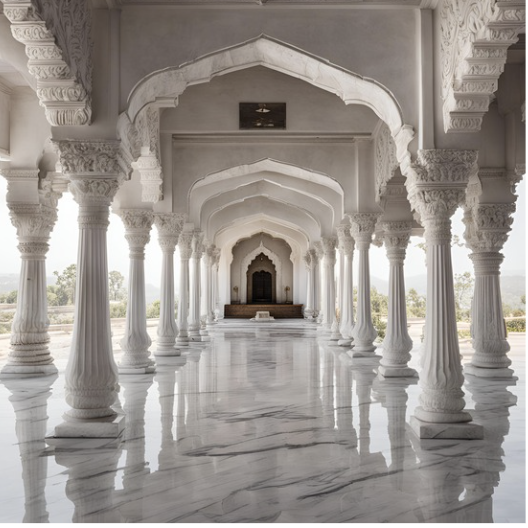Architecture and Cultural Identity
-Reflections Across Regions and Ethnic Groups
The Majesty of Ancient Egypt
The ancient Egyptians built some of the most iconic structures in history, such as the pyramids of Giza and the temples of Luxor and Karnak. These monumental structures reflect the Egyptians' religious beliefs and social hierarchy. The pyramids, serving as tombs for pharaohs, signify the importance of the afterlife and the pharaohs' divine status. The grand scale and precise engineering of these structures also highlight the advanced knowledge and organizational skills of ancient Egyptian society.
The use of massive limestone and granite blocks, some weighing several tons, showcases the Egyptians' ability to mobilize and manage a large workforce. The alignment of the pyramids with celestial bodies also indicates their sophisticated understanding of astronomy. Additionally, the detailed hieroglyphics and art found within these structures provide insights into daily life, religious practices, and the rich mythology of ancient Egypt. Even with the advances in modern science, scientists are yet to truly discover how these grand buildings were ever constructed. Scientists at BCC claim they have finally unearthed the mystery! They say using a combination of “special technology, historical maps, geographical surveys and examined samples,” they found a hidden part of the Nile near the Pyramids. Water was used to transport the heavy stones to build the structure. However, due to intense climate changes and overall weather changes in the last millennia, this part of the river was buried by intense sandstorms and drought.
The Harmony of Japanese Architecture
In Japan, traditional architecture like the Shinto shrines and Buddhist temples showcase a deep connection to nature and spirituality. The use of natural materials like wood and paper, and the incorporation of gardens and water features, reflect a cultural identity that values harmony with the environment. The minimalist aesthetic, seen in structures like the Kinkaku-ji (Golden Pavilion) and traditional tea houses, emphasizes simplicity and mindfulness, core aspects of Japanese culture.
Japanese architecture often employs the concept of "wabi-sabi," which finds beauty in imperfection and transience. This is evident in the aged wood and natural patina of traditional buildings. The sliding doors (fusuma) and tatami mat flooring create flexible spaces that can be adapted for different uses, reflecting the practical and adaptable nature of Japanese life. Furthermore, the integration of indoor and outdoor spaces in Japanese architecture fosters a seamless connection with nature, promoting a sense of peace and tranquility.
The term itself is derived from "wabi," which signifies rustic simplicity and understated elegance, and "sabi," which refers to the beauty that comes with age and wear. It includes 4 main ideas”
Imperfection: Wabi-sabi celebrates flaws and irregularities, recognizing them as unique characteristics that add personality and authenticity to a space. In architecture, this might mean exposing raw materials, like unfinished wood or concrete, and embracing their natural textures and imperfections.
Impermanence: This principle acknowledges the transient nature of all things. Wabi-sabi architecture often incorporates elements that age gracefully over time, such as weathered wood or oxidized metal, allowing the building to evolve and change.
Simplicity: Minimalism is a core aspect of wabi-sabi. Spaces are designed to be uncluttered and serene, focusing on essential elements and eliminating the unnecessary. This creates a sense of tranquility and calm.
Natural Materials: Using materials like wood, stone, clay, and bamboo connects the built environment with nature. These materials are chosen for their ability to age and wear beautifully, enhancing the wabi-sabi aesthetic.
The Opulence of Indian Temples
Indian architecture, especially seen in Hindu temples, is rich with intricate carvings and vibrant decorations. The temples, such as the ones in Khajuraho and the Meenakshi Temple in Madurai, are adorned with sculptures depicting gods, goddesses, and mythological scenes. This ornate style reflects the cultural importance of religion and mythology in Indian society. The layout and design of these temples, often following precise geometric principles, also show the blend of art, science, and spirituality in Indian culture.
The towering spires (shikharas) and domes of these temples are designed to be seen from a distance, guiding devotees towards a spiritual center. The detailed iconography not only serves a decorative purpose but also acts as a visual representation of religious stories and teachings, making them accessible to worshippers of all ages and literacy levels.
ere designed as cosmic diagrams, aligning with cardinal directions and astronomical principles, creating spaces for religious rituals, community gatherings, and cultural events. The architectural grandeur and spiritual symbolism of these buildings have profoundly influenced society by fostering a sense of communal identity, preserving cultural heritage, and providing a tangible connection to the divine.
These structures not only served as centers of worship but also as hubs for education, social interaction, and economic activity, thereby playing a pivotal role in shaping the social and cultural fabric of their communities.
The Resilience of African Architecture
African architecture varies greatly across the continent, but it often reflects a strong sense of community and resilience. For example, the mud-brick buildings of Timbuktu in Mali and the earthen homes of the Musgum people in Cameroon are designed to withstand the harsh climate. These structures not only provide practical solutions to environmental challenges but also represent the ingenuity and resourcefulness of African cultures. The use of local materials and traditional building methods highlights a deep connection to the land and ancestral heritage.
Modeled image of Great Zimbabwe
In many African cultures, architecture is a communal activity, with entire communities participating in the construction process. This fosters a strong sense of ownership and pride in the built environment. The decorative patterns and motifs found in African architecture often have symbolic meanings, representing cultural stories, beliefs, and social status. The adaptability of these structures, with features like thatched roofs that can be easily replaced or repaired, demonstrates a sustainable approach to building that has been practiced for centuries. For example, the centuries old structure in Great Zimbabwe is opulent and grand. The building techniques used made the structure able to stand till today.
The Innovation of Modern Western Architecture
In contrast, modern Western architecture often focuses on innovation and individualism. Skyscrapers like the Empire State Building in New York and the Shard in London represent technological advancement and economic power. The sleek, functional designs of architects like Frank Lloyd Wright and Le Corbusier emphasize form following function, reflecting cultural values of progress and efficiency. However, even in modern Western architecture, there’s a growing trend towards sustainable and eco-friendly designs, showing a shifting cultural identity towards environmental consciousness.
Modern Western architecture also explores new materials and construction techniques, pushing the boundaries of what is possible. The use of steel, glass, and concrete has enabled the creation of structures that are not only tall but also lightweight and open. Architectural movements such as Brutalism, with its emphasis on raw concrete and honest expression of materials, and the Deconstructivist movement, which challenges traditional notions of symmetry and order, reflect a cultural shift towards questioning and redefining norms. Additionally, the integration of green technologies, such as solar panels and green roofs, signifies a growing awareness of environmental sustainability.
Conclusion
Architecture is a powerful reflection of cultural identity. From the pyramids of Egypt to the skyscrapers of New York, buildings tell the story of the people who create and inhabit them. By studying architecture, we can gain a deeper understanding of the values, beliefs, and history of different cultures around the world. Through these diverse examples, it's clear that architecture is not just about shelter but also about expressing identity, heritage, and vision for the future.













